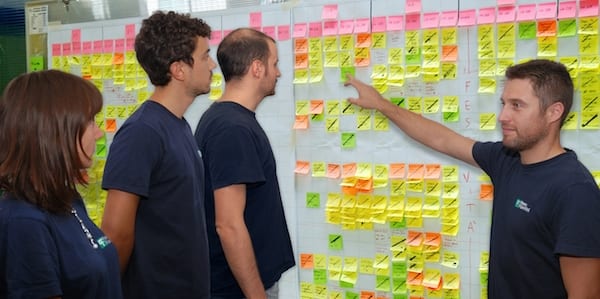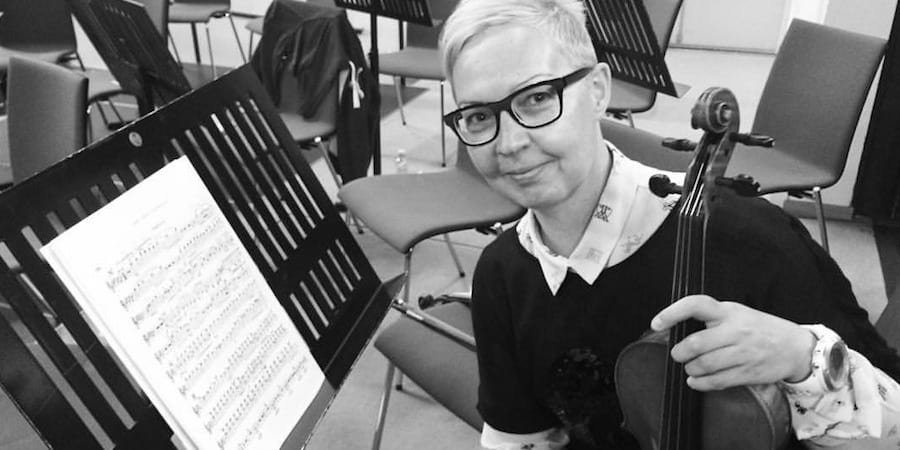
The path to a learning organization
CASE STUDY – The story of this NGO shows how visual management enables improvement and removes barriers among teams. It is a first, fundamental step towards a lean transformation.
Words and Copyright: Steve Bell and Karen Whitley Bell
“Who are these visuals for? The leadership, or us?” one team member asked as the practice of Obeya was introduced at a large organization launching a full-scale transformation effort complete with an enterprise-wide reorganization and newly formed multi-disciplinary, multi-location teams (Value Stream teams parsed into “tribes” and “squads”). Teams were also coping with a host of new roles, new reporting structures, and new ways of work. Given the scale and speed of change within this organization, it’s easy to understand why this question was being asked. As master coaches halfway around the world, we pondered how to help this newly minted coaching community help everyone across the enterprise unpack this question—understanding not only the question, but, more importantly, why it is being asked. At its core lies a deeper question, which keeps C-level leaders up at night: “What does it take to realize transformation success?”
Travel with us from this Asia-Pacific enterprise to Kampala, Uganda, where six years ago we engaged in some pro-bono work to help NGO Grameen Foundation scale a successful innovation from Uganda to other developing countries in Africa and around the globe. This innovation involved hiring locals with knowledge of farming and customs, and equipping them with specially programmed Smartphones to visit rural farmers, where they shared information to help these farmers optimize crop yields and sales value. Thus, they enhanced local knowledge using digital capabilities to help improve the lives of those who otherwise would not have this knowledge. They called this information delivery system the Community Knowledge Worker Program (CKW). We were there to help the CKW team transform their heroic, just-make-this-happen approach to scalable, repeatable processes that could be adapted across different cultures and government practices.
After a learning day on the field with the program’s customers deep in the countryside of Uganda, we turned our gemba to Grameen Foundation’s Kampala office, comprised of two large rooms, one with movable tables arranged as a single long table to seat everyone and the other arranged as an open area with small cubicles serving as a working space for each person. Clustered on one side of this room were the cubicles of the CKW team (about 25 people) and on the other side, “IT”, another 25: two very distinct areas with what felt like an invisible line between the two.
We moved to the long table to kick off the session, and were surprised when the IT team did not join in. The Country Director explained that the IT team delivered the NGO’s principal product—phone-enabled financial services—and that the revenues from this, coupled with donor support, had enabled the development of the rural CKW program, including expanded hiring to operate it. The IT team saw the CKW program as drawing resources away from them and from their principal work. He shared that for many NGOs, the pay scale was less than local for-profit organizations, and since programming and technology service management were in-demand skills, it was common for for-profits to hire away entire IT teams. All technologists were in demand, and those with experience in financial services even more so. The Country Director was carefully weighing the needs of the startup CKW program with the needs of his existing operations – a balancing act many leaders face on a daily basis.
So, we proceeded with the CKW team and without IT. We started by mapping the process. Based on our conversations in advance, we’d recognized that the traditional value stream map approach would not convey the complexity and inter-relationships. This was not a linear process. It was multi-dimensional. We guided the team to visualize this complexity. This approach became the basis of what we would, over time, evolve into what we call a Multi-Dimensional Value Stream Map. We handed out Post-Its and pens. After the first few rounds of facilitated questioning and encouragement to write what had just been said, the team caught on and the tenor of the room rose, from silent, individual writing, to full-blown animated engagement as the team began to see the connections—and challenges of their work—in a way they never had before. Now and then, as the energy and noise level rose, members of the IT team would periodically look in. At breaks, one or two would come examine the wall, occasionally picking up a pen and silently filling in a blank left for IT, or add a missing IT input, but for the most part, the IT team remained aloof.
We followed this with a speed course on disciplined problem solving, stand-up rituals, and team and individual visualization tools like kanban. On our last day, the IT team asked for some of our time, and we provided some coaching, blending Agile, Scrum, and Lean as appropriate to the situation. Too often, in too many organizations, these practices are viewed as competing domains. Yet they are founded on many of the same principles and share the same goals. Each discipline has much to offer, and the enterprise that recognizes this and brings these approaches together has, in our view, an advantage in this increasingly digitally enabled, global economy.
When we left Kampala, the walls around the CKW team were covered in visuals, including team flow boards with demand prioritization and WIP, problem boards, metrics toward targets, and team status boards with information like who was where during the current week. At each desk, personal kanbans were bordered by pictures of kids and family and friends. The team visuals oriented everyone to the work that needed to be done right now, the problems or obstacles associated with that work, and the work that was waiting to be done once resources became available. The personal kanbans offered this same information at the individual level, providing additional depth behind the verbal daily standups.
A few months later we caught up with the Country Director. Something remarkable had happened. Productivity was up, waste was down, processes were continuing to be refined and improved and standards were being readied for roll-out in the next wave of countries. The Monday morning “all hands” ritual at the long table had transformed from a multi-hour time suck to quick daily standups. The CKW team was in full-on collaboration mode, with people constantly viewing and updating the team visuals, and leaning over their colleagues’ shoulders to view the personal kanbans. All day long he’d hear, “I can help with that.”
He too started visiting the teams’ visuals, though he admits that, at first, the team was a bit unsettled by this. While it did help him to see the status, the real value was seeing the obstacles that were holding the team back, obstacles that often required his involvement to resolve or remove. They now invited him over whenever something came up. He was now a collaborator, not just “the boss.”
All this was great, he added, but there was more. The IT team had been quietly observing all of this. Now and then they’d step close to examine the visuals. Before long similar visuals began to appear on their side of the room. Then one day, as an IT team member was studying one of the CKW team’s visuals, he leaned in and said, “I can help with that.”
Back to Asia-Pacific, and to your own organization. What is the goal of a “transformation”? To transform means, quite simply, to significantly change. What are we changing to? Billions of dollars are spent in organizations around the world in pursuit of this question. Ultimately, we are seeking what this NGO senior leader sees: a highly collaborative learning environment, where everyone brings their knowledge and experience together to create and continue to improve great customer experience and value.
To learn we must invite learning, actively sharing where we are, where we hope to go, and where we’re stuck. Making the work visible (physically, and when appropriate, virtually) is a way to help us improve our work. It’s also a way to invite and enable collaboration with our peers, with our colleagues who bring diverse knowledge, skills and ideas, and with leadership who can remove the obstacles that hold teams back. Of course, transparency requires trust, and collaboration at scale requires disciplined practice and structures, but one of the simplest ways you can begin to transform the way work is done is to visualize the work. Across a room, a campus, a company. Across time zones, capabilities, and cultures. Across any invisible line that separates one person’s capabilities and knowledge from another. Transforming the way we engage and work. Learning and collaborating. “I can help with that.”
For a view into transformation at scale, you can read about ING Bank’s journey blending Lean, Agile, DevOps and other disciplines to enhance agility and value in the book Accelerate, recent recipient of the Shingo Institute Publication Award. A free download of the section on High Performance Leadership and Management, including the ING learning journey, is available here.
THE AUTHORS

Read more


CASE STUDY – This Shared Service Center in Poland has leveraged lean, technology, and automation to completely transform itself and provide an ever-better customer experience.


INTERVIEW – A new book on hoshin kanri is out! We sit down with the author to learn about the publication and how it can help organizations.


CASE STUDY – A unique approach to lean management and the involvement of CEO Mario Nardi helped Pietro Fiorentini, provider of solutions for natural gas distribution, become a model for lean companies in Italy.


PROFILE – Persevering, letting people inspire you and committing to continuous learning. These are the things you need to do to successfully embrace lean thinking and, it turns out, learn to play the violin.

